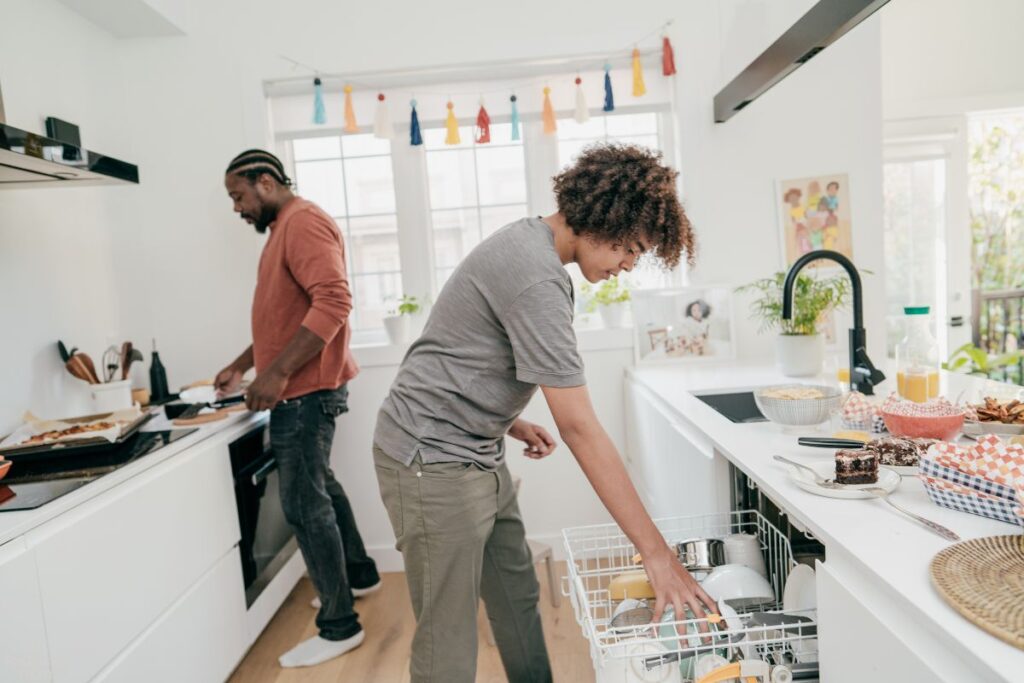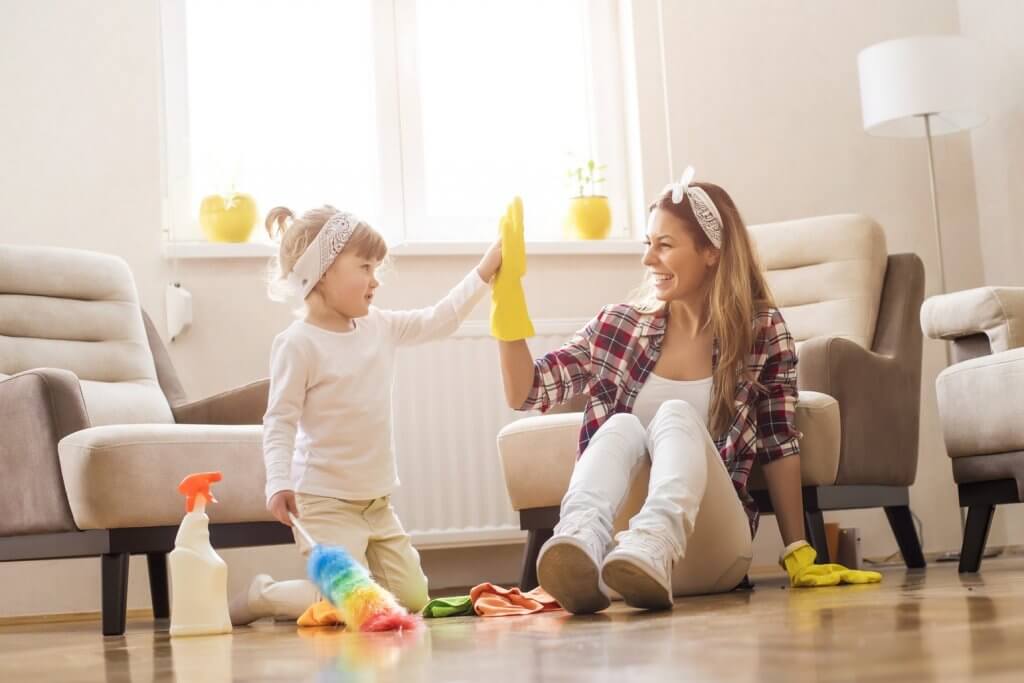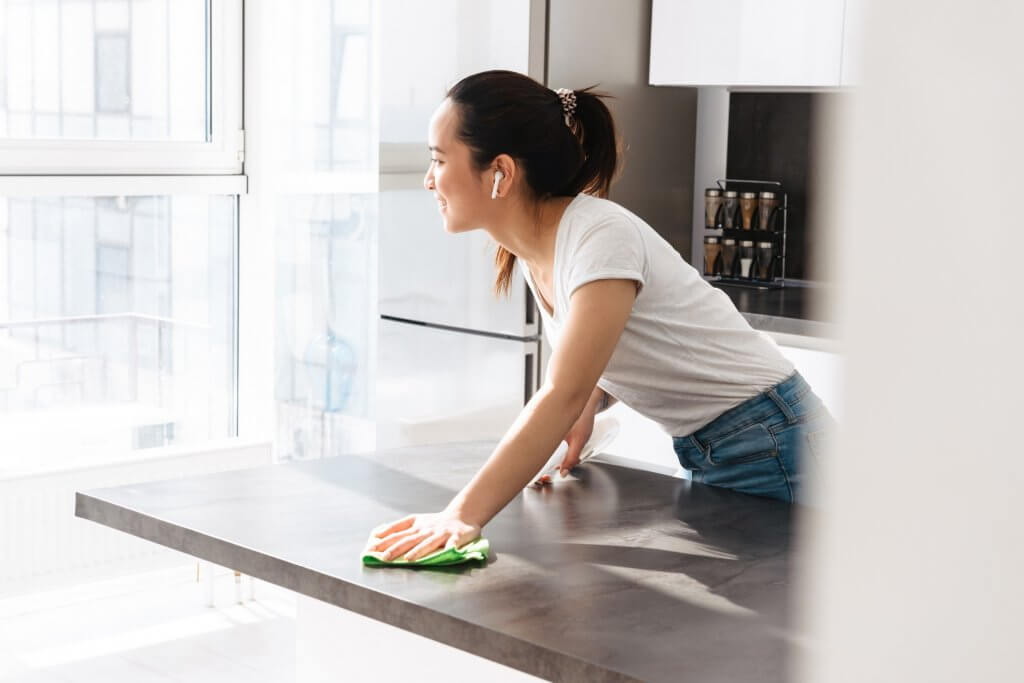Inside: Learn what Swedish “Städdag” is and how you can use it to optimize your cleaning routine.
A guest post by Evelyn Long
Everyone wants to minimize messes and clutter without becoming overwhelmed or sacrificing their precious free time.
Consistency and community are the two most critical components of keeping a neat home — things Swedish people have mastered through a concept called städdag.
Read on to learn more about this approach and how to use it to build a cleaning habit that may even help strengthen your relationships.

What Is Städdag?
A recent survey found that 87% of Americans feel physically and mentally better when they have a tidy home, so it’s vital to make cleaning a habit.
The Swedish word “städdag” literally translates to “cleaning day,” a calendar event where households and sometimes entire communities come together to tidy up their spaces.
It can come in many forms. For example, your family could set aside every Saturday as your weekly städdag, where you divide tasks and clean your home from top to bottom.
If you live in an apartment complex or a tight-knit neighborhood, the städdag could extend to the community, where everyone comes together to maintain shared spaces.
This method shares similarities to the Sunday reset trend made popular on TikTok, where people set aside a day to tidy up and prepare for the coming work week.
More than checking chores off a to-do list, städdag operates on a philosophy of creating calm and balance in the home where you might spend most of your time, especially in colder months.

How Swedish Städdag Can Enhance Your Life and Cleaning Routine
Städdag goes beyond a cleaning strategy. At its core, it’s an approach to home and life that can bring multiple benefits.
1. Keeping Spaces Tidy
Neatness is the most straightforward reason to practice städdag.
Having a regular cleaning day on your calendar means you can look forward to having a well-organized living space for at least one day a week, making it easier to keep it that way with a couple of minutes of daily tidying.
Aside from removing dirt and clutter, regular cleaning also reveals potential issues or damage in your home.
2. Building a Habit
Sticking to a routine may be a cinch if structure and order come naturally to you. However, this consistency can be challenging for others.
Scheduling a weekly or biweekly städdag can ease you into the practice. This cleaning day may become something you look forward to when you know you’ll have someone to help you finish your chore list.

3. Nurturing Relationships and Community
A unique benefit of städdag is that it connects you with your loved ones and community. Cleaning is no longer a dreaded chore — it’s a chance to spend quality time with your family, friends, and neighbors.
Apartment buildings, condos, neighborhoods, and even schools can schedule collective maintenance days where people take care of common spaces and get to know each other.
These relationships are vital for your well-being. Current research shows a correlation between a positive sense of community and reduced stress, depression, and anxiety.
How to Participate in Swedish Städdag
Städdag is relatively easy to implement in your household. On your chosen day, gather the entire family and assign rooms or tasks.
The more people there are, the easier it will be to clean the whole house from top to bottom. If you live alone, you can set up a group call with some friends and do a remote städdag.
Want to expand your community? Contact your neighbors or HOA and make it a regular event.
Cleaning and improving your shared areas, such as parks, sidewalks, and community gardens, is an excellent way to bond. Who knows? You and your family might make a friend or two.

Strategies to Maximize Your Städdag
The städdag is a scheduling and mindset technique for cleaning — you can technically do anything you want on these days, as long as improvement is your overarching goal.
If you want to switch up your methods, here are five strategies to make your städdag more effective and efficient.
1. Create a Plan
Every successful cleaning session begins with everyone knowing what they need to do.
Before your städdag, briefly meet with everyone and assign specific tasks to ensure you don’t overlook anything. If you’re working with your family, you can assign one person per room or chore.
Here are some chores you might want to include in your cleaning routine:
- Disinfecting remote controls and computer keyboards
- Vacuuming and mopping floors
- Cleaning showerheads, sinks, toilets, and drains
- Washing your sheets, pillowcases, and towels
- Throwing out expired food
2. Begin by Tidying Up
Scattered items around the house and on surfaces can quickly make your home feel messier.
Return things like clothes, shoes, books, and toys to their proper places. Carry a trash bag if you discover anything you need to throw away.
Clearing clutter as your first step makes cleaning easier, as you won’t have to maneuver around loose objects.

3. Prioritize the Bathroom and Kitchen
Your bathroom and kitchen are two of the most heavily used spaces in the house and will take up the most time.
Pretreat stubborn stains and use appropriate products for each area. Wipe down every surface and appliance to remove grime, grease, and dust.
Pay attention to items or surfaces requiring extra attention or careful handling, such as electronics, hardwood floors, or granite countertops.
4. Work From the Top Down
Working from top to bottom is a practical housekeeping rule that professionals follow to make cleaning more efficient.
Starting from the highest areas of your home allows dirt and dust to fall and minimizes the chances of clean places getting dirty again.
For example, when working on your living room, dust off cobwebs from the ceiling, then move on to your shelves, bookcases, and furniture.
Tackle the floor last — it will have collected all the dirt from the rest of the room.
5. Clean Your Tools
Cleaning your house properly means working with clean tools. Fresh rags and mops are more effective and absorbent, helping you save time and do a better job.
They’re also safer — leaving things dirty for too long could allow them to grow mold and harmful bacteria.

It Takes a Village
Your positive attitude can transform cleaning from an unpleasant endeavor to a fulfilling task necessary for a happy, healthy life.
Städdag captures this approach perfectly. It teaches you to view cleaning as an act of care needed to sustain strong communities.
With this cleaning strategy, you can end up with a sparkling home and mutually beneficial relationships.

Evelyn Long is a home organization writer who helps homeowners and renters maintain a neat space through innovative decluttering tips. She has written for several other publications, including the National Association of Realtors and DecorMatters. She is also the editor-in-chief of Renovated Magazine, where she shares additional tips on decluttering and home organization.
What do you think about Swedish “Städdag”? If you give it a try, let us know how it goes!
Sign up on the form below to get weekly decluttering tips and inspiration sent straight to your inbox. You’ll also get the free 5 Areas to Declutter in 10 Minutes Checklist to help you get started decluttering today.

